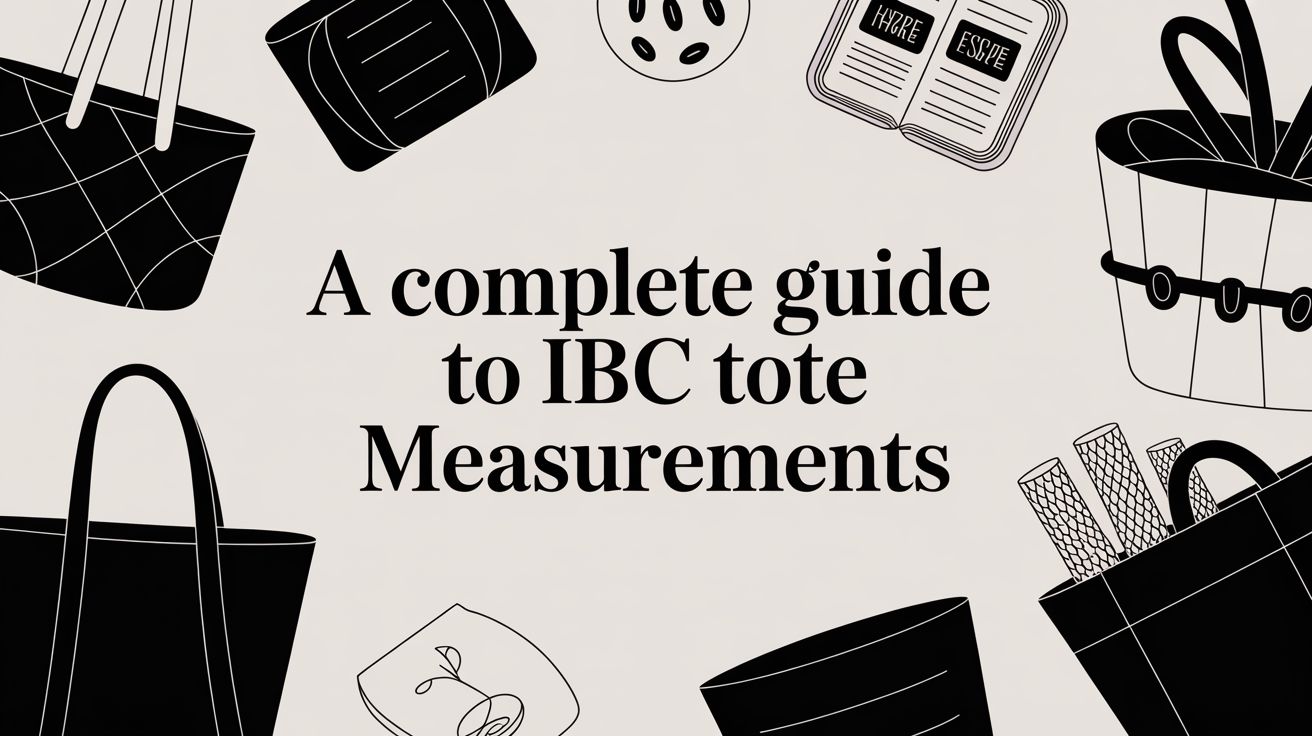
A Complete Guide to IBC Tote Measurements
When you’re dealing with IBC totes, the first thing to know is that they come in a few standard sizes, but two dominate the North American market: the 275-gallon and the 330-gallon models. Getting these measurements right is absolutely critical for everything from warehouse racking to figuring out shipping costs.
The most common footprint for a 275-gallon tote is around 48″ x 40″, while the larger 330-gallon tote typically sits on a 48″ x 48″ base. These dimensions aren’t accidental—they’re designed to fit perfectly on standard pallets and maximize space in trucks and on storage shelves.
Your Quick Guide to Standard IBC Tote Measurements
If you’re planning your workspace or organizing a shipment, you need the exact specs. The 275 and 330-gallon totes are the workhorses of countless industries for a reason: they are built for logistical efficiency.
So what’s the real difference? It mainly comes down to height. The 275-gallon model is shorter, which is a big advantage when you have lower ceilings or need to double-stack in certain situations. The 330-gallon version, on the other hand, gives you that extra volume on a slightly wider footprint. These external dimensions dictate exactly how many totes you can line up, stack up, or load up.
This infographic breaks down the key differences in capacity, footprint, and height at a glance.
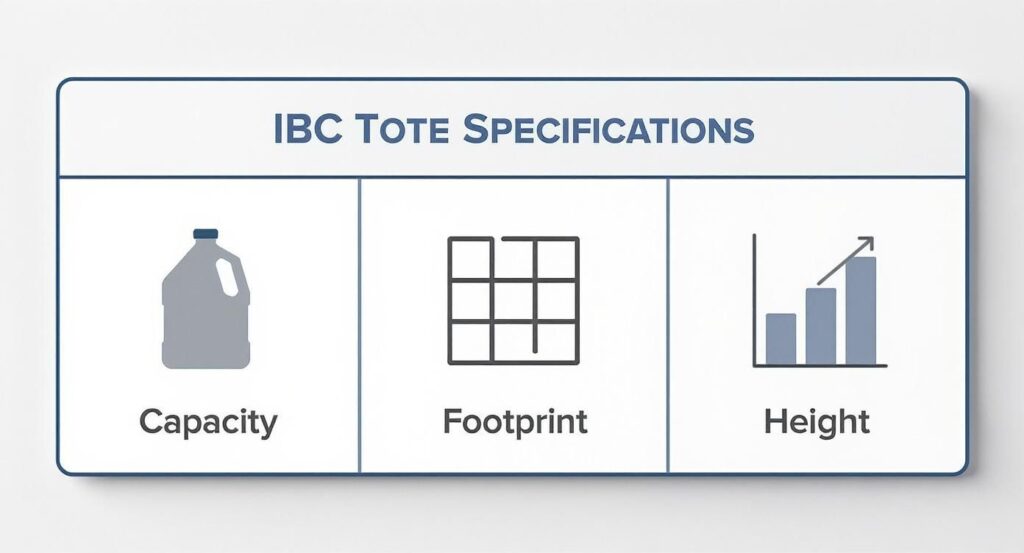
You can see right away how the 330-gallon tote gets its extra capacity from its height, with only a small increase to its base.
Standard 275 vs 330 Gallon IBC Tote Specifications
Putting the two most common sizes side-by-side is the easiest way to see which one fits your needs. Here’s a detailed breakdown of the typical measurements you’ll encounter.
| Specification | 275 Gallon (1040 Litre) IBC Tote | 330 Gallon (1250 Litre) IBC Tote |
|---|---|---|
| Nominal Capacity | 275 US Gallons / 1040 Litres | 330 US Gallons / 1250 Litres |
| Length (L) | 48 inches (1219 mm) | 48 inches (1219 mm) |
| Width (W) | 40 inches (1016 mm) | 48 inches (1219 mm) |
| Height (H) | 46 inches (1168 mm) | 53 inches (1346 mm) |
| Pallet Footprint | 48″ x 40″ | 48″ x 48″ |
| Empty Weight (Tare) | Approx. 135 lbs (61 kg) | Approx. 155 lbs (70 kg) |
| Filled Weight (Water) | Approx. 2,425 lbs (1100 kg) | Approx. 2,915 lbs (1322 kg) |
This table gives you a clear, direct comparison, making it much simpler to plan your logistics and storage requirements based on the specific tote you’re using.
While you can find IBC totes ranging anywhere from 110 to 550 gallons, the 275 and 330-gallon versions remain the most popular in Canada and the US simply because they work so well with existing logistics infrastructure.
It’s also worth noting that regulations come into play. For instance, federal guidelines can dictate how much residue is permissible in an empty container—often no more than 0.3% of its total capacity. This is a crucial detail for anyone dealing with transport and compliance. To get a deeper dive into these kinds of specifications, you can find more great insights on IBC tote usage and standards at Repackify.
Understanding IBC Tote Capacity and Dimensions
When you’re working with Intermediate Bulk Containers (IBCs), everything boils down to two key factors: capacity and dimensions. These numbers might seem basic, but getting them right is the difference between a smooth operation and a logistical headache. It dictates how you store, handle, and ship your product, and a small miscalculation can lead to totes that won’t fit your racking or running out of warehouse space when you least expect it.
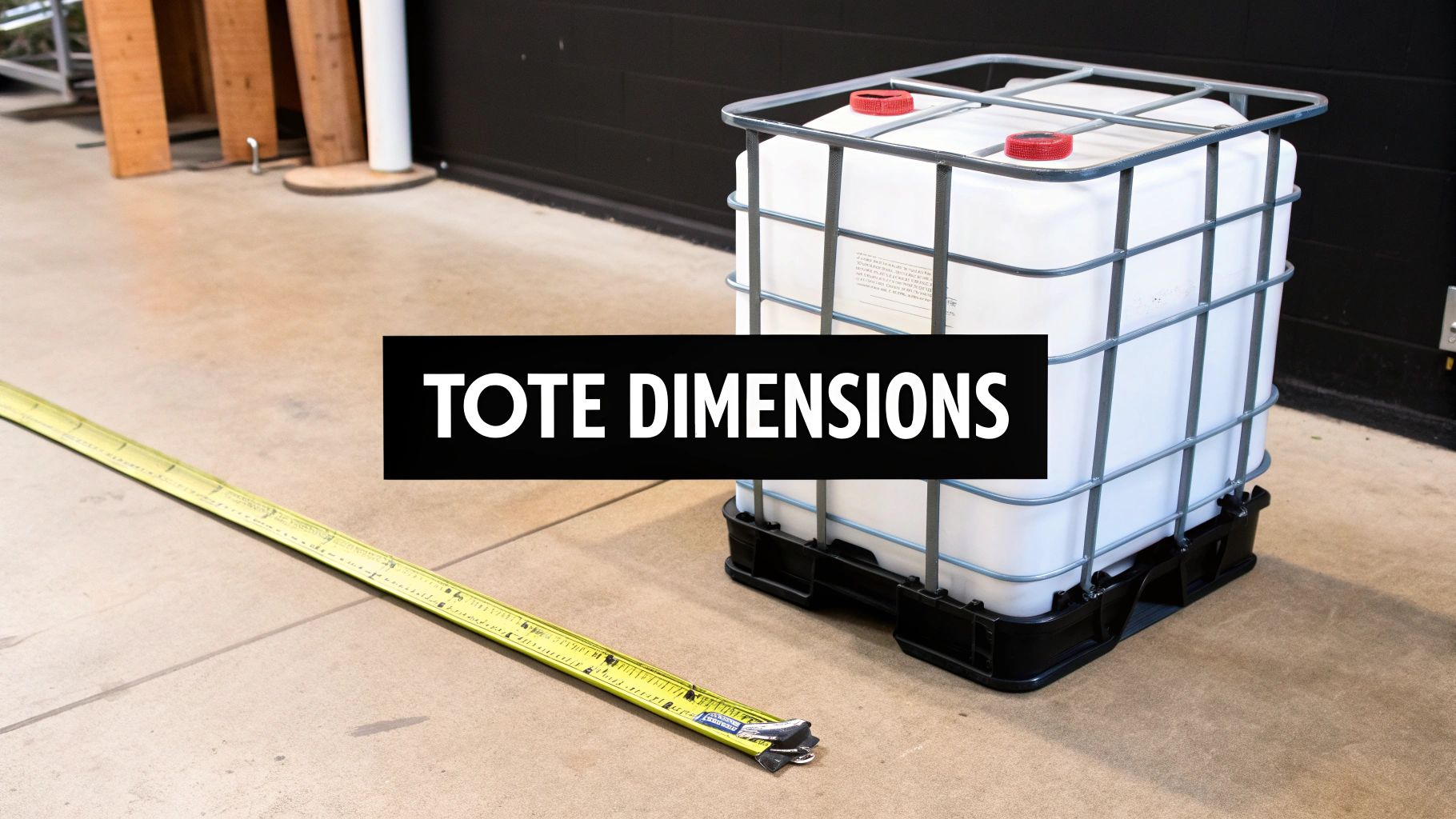
In Canada, you’ll almost always encounter two standard sizes: the 275-gallon (1040-litre) tote and the slightly larger 330-gallon (1250-litre) model. The best choice for you really depends on the volume of product you’re moving and the physical layout of your facility.
Decoding Standard IBC Tote Volumes
A tote’s volume isn’t just a number on a spec sheet—it directly impacts your inventory management. The 275-gallon model is a real workhorse, perfect for smaller production runs or for facilities where space, particularly vertical height, is at a premium. Its more compact profile can make it a lot easier to manage in tight spots.
On the other hand, the 330-gallon tote is all about maximizing volume on a slightly bigger footprint. It’s the go-to for operations that need to move or store large quantities of liquid in one go. Using the larger size can often mean fewer totes to handle, which simplifies logistics quite a bit. If you’re considering this option, you can see if the specific measurements of a 1250-litre (330-gallon) IBC tote fit your workflow.
Pro Tip: Try to match your tote capacity to your average batch size. Using a tote that’s too big can mean product waste and more intensive cleaning, while using one that’s too small just creates extra handling and inefficiency.
External Dimensions and Logistical Impact
The external measurements—length, width, and height—are the numbers that matter most for planning. These figures determine exactly how many totes you can load into a shipping container, fit on a truck, or line up in your warehouse.
Length and Width (Footprint): The base dimensions are crucial for pallet and racking compatibility. The common 48″ x 40″ footprint of a 275-gallon tote, for instance, is no accident; it’s designed to fit perfectly on a standard pallet.
Height: This is the key dimension for stacking and overhead clearance. When planning your storage, you have to account for the tote’s full height plus any extra room needed for pump fittings, hoses, or the forks of a lift truck.
Think about it this way: a standard 40-foot shipping container can usually hold 18 to 20 stacked 275-gallon totes. But that number can easily change depending on the container’s exact internal dimensions and the space taken up by dunnage. Calculating your storage density based on these external dimensions is how you make sure you’re using every square metre of space safely and effectively.
Getting a Handle on IBC Tote Weights
When you’re working with IBC totes, knowing their dimensions is only half the battle. To handle them safely and manage logistics effectively, you absolutely have to understand their weight—both when they’re empty and when they’re full. These two figures, the tare weight (empty) and the gross weight (filled), are critical pieces of information for everyone from the forklift operator on the floor to the shipping coordinator planning a load.
The tare weight is straightforward: it’s what the tote weighs on its own, completely empty. This number is a sum of its parts—the inner plastic bottle, the protective steel cage, and the pallet base it sits on.
Why Tare Weight Isn’t Always the Same
You might see a standard 275-gallon tote listed with a tare weight of around 135 pounds (61 kg), while its bigger sibling, the 330-gallon tote, comes in at about 155 pounds (70 kg). Think of these as good ballpark figures, but the real weight can shift based on the materials used. The pallet, in particular, is a major variable.
- Composite Pallets: These steel-and-plastic hybrids are the most common and typically align with those standard weight estimates.
- All-Steel Pallets: If you’ve got a heavy-duty tote, it might be sitting on an all-steel pallet. This adds some serious reinforcement but can also tack on an extra 15-25 pounds to the total empty weight.
- All-Plastic Pallets: These are great for preventing corrosion and are often a bit lighter than the composite versions.
The golden rule? Always check the manufacturer’s data plate on the tote itself. That number is the official tare weight you need for your calculations, ensuring you don’t inadvertently push past the weight limits of your equipment or vehicles.
Calculating the Filled Weight of an IBC Tote
Figuring out the gross, or filled, weight is a crucial step for both safety and legal compliance. It’s not just a matter of adding the liquid’s weight; you have to account for how dense that liquid is. This is where specific gravity (SG) comes into play.
Specific gravity is just a simple ratio that compares a liquid’s density to the density of water. Water itself has an SG of 1.0. So, if you’re storing a product with an SG of 1.2, it’s 20% denser than water. If the SG is 0.8, it’s 20% lighter.
Here’s the straightforward formula to get your total gross weight:
(Liquid Volume in Gallons x 8.34 lbs/gallon x Specific Gravity) + Tare Weight of Tote = Total Gross Weight
Here’s a Real-World Example:
Imagine you need to fill a standard 275-gallon tote (which we’ll say has a tare weight of 135 lbs) with a liquid that has a specific gravity of 1.2.(275 gallons x 8.34 lbs/gallon x 1.2) + 135 lbs = 2,752 lbs + 135 lbs = 2,887 lbs total weight.
Running this quick calculation is your best defence against dangerous overloads. It tells you if your forklifts can handle the job, if your warehouse floor can bear the load, and if your truck is within its legal weight limits for transport. Getting the weight right isn’t just about paperwork—it’s about preventing accidents and avoiding some seriously expensive fines.
A Guide to Valves, Lids, and Fittings
An IBC tote’s real-world usability doesn’t come from its tank or cage, but from its connection points. It’s the valves, lids, and fittings that determine whether your tote integrates smoothly with your pumps, hoses, and other equipment. Honestly, this is where most mistakes are made, leading to nagging leaks, bad seals, and frustrating downtime.
Getting these connections right is fundamental. From the large fill cap on top to the discharge valve at the bottom, every component has specific measurements. Nailing these details from the get-go saves you from the classic headache of ordering an adapter that looks perfect online but is a couple of millimetres off in reality.
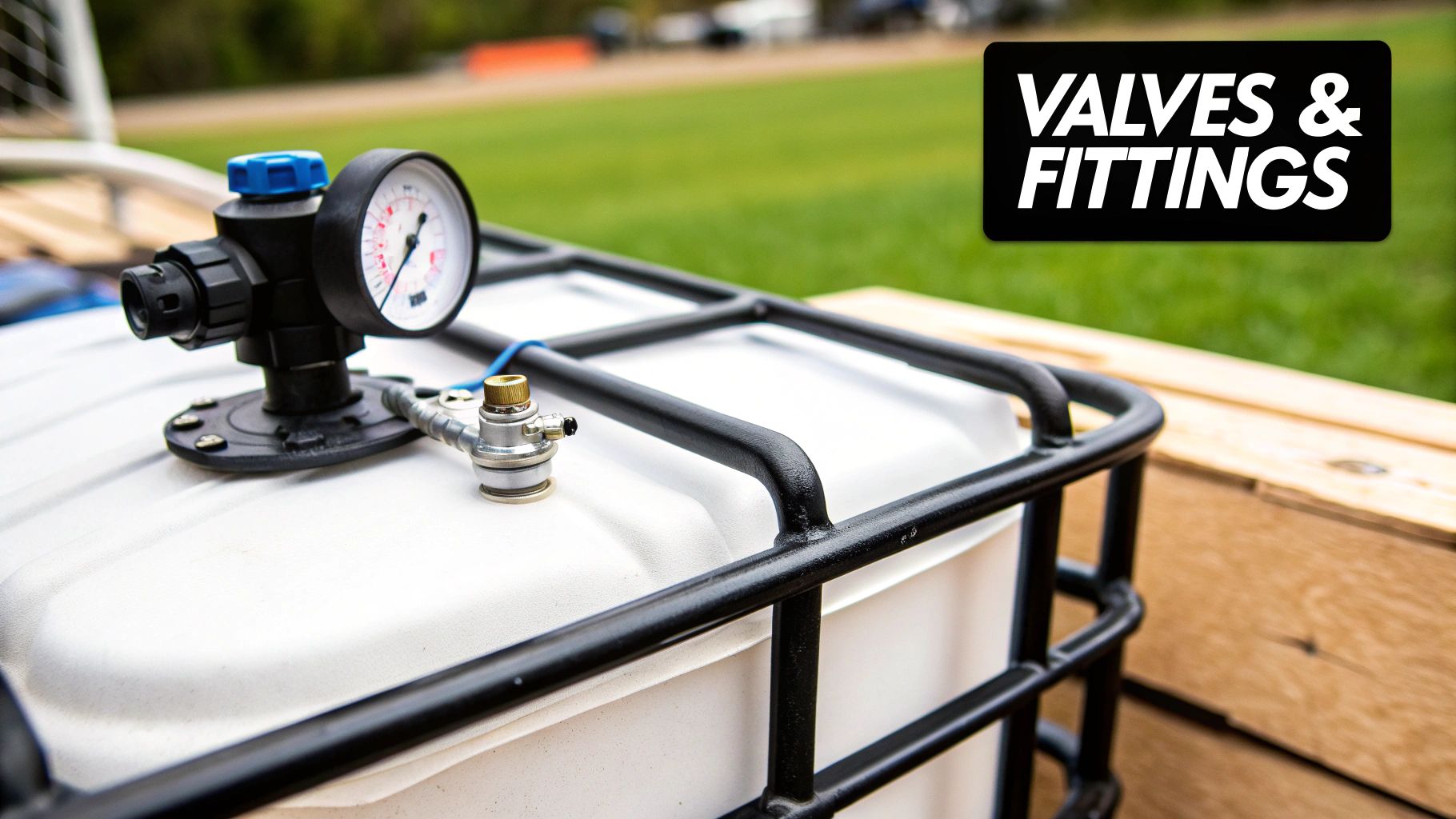
Measuring Lids and Openings
The top opening is sealed with a large screw-on lid, and thankfully, there are really only two standard sizes to worry about. Measuring it is dead simple—just grab a tape measure and check the diameter straight across the opening.
- 6-Inch (150 mm) Lids: This is the workhorse size. You’ll find it on the vast majority of standard 275-gallon and 330-gallon totes.
- 9-Inch (225 mm) Lids: While less common, these larger lids are used on specialty totes designed for faster filling or for handling bulkier solid materials.
You’ll also need to decide between a vented or non-vented lid. A vented lid is essential if you’re dispensing contents that could create a vacuum, like when you’re pumping liquid out quickly. It lets air in to equalize the pressure so the tote doesn’t crumple inward. On the other hand, a non-vented lid offers a complete, airtight seal, which is necessary when transporting materials that can’t be exposed to air.
Identifying Outlet Valve Threads
The outlet valve at the base of the tote is where things get tricky. With so many different thread types out there, getting a mismatch is a guaranteed recipe for a leak. The two most common thread standards you’ll encounter are Buttress (a coarse thread) and NPT (a tapered, fine thread).
To figure out what you’ve got, you need to take two measurements:
- Outer Diameter (OD): Using a pair of calipers for accuracy, measure from the outside edge of a thread directly across to the opposite outside edge.
- Pitch: This is the distance from the peak of one thread to the peak of the next.
A very common coarse thread you’ll see is the S60x6. This simply means it has a 60 mm outer diameter and a 6 mm pitch (distance between threads). A lot of people mistake this for a standard 2-inch pipe thread, which is a frequent and costly error.
The table below breaks down the most common valve thread types you’re likely to encounter. Use it as a quick reference when you’re out in the yard trying to identify a fitting.
Common IBC Tote Valve Thread Sizes and Identifiers
| Thread Type | Common Diameter | Thread Pitch (Coarse/Fine) | Typical Application |
|---|---|---|---|
| S60x6 | 2.36″ (60 mm) | 6 mm (Coarse) | The most common European/International standard found on Schutz, Mauser, and many other brands. |
| 2″ NPT | 2.35″ (59.6 mm) | Fine | A standard North American tapered thread. Common on domestically produced totes. |
| 2″ Camlock | 2.5″ (63 mm) | N/A (Male Adapter) | A quick-connect fitting, not a thread. Often found on valves for fast hose connections. |
| S100x8 | 4″ (100 mm) | 8 mm (Coarse) | A larger Buttress thread used for high-flow applications. Less common on standard totes. |
Having these precise measurements in hand is the only way to confidently select the right adapters and accessories.
Once you know your tote’s measurements, you can ensure your camlock fittings, hoses, and nozzles connect securely every time. If you need to source parts, you can browse a complete list of IBC tote valve assemblies and components to find a guaranteed fit. Proper identification is the key to maintaining a safe, efficient, and leak-free system.
Stacking Capabilities and Safety Ratings
Anyone trying to make the most of their warehouse space knows that stacking IBC totes is a go-to strategy. It’s efficient, but it has to be done safely. Overlooking the specific ratings and measurements for stacking isn’t just a minor oversight—it can lead to catastrophic structural failures, expensive spills, and, worst of all, serious injuries.
The most important piece of information for safe stacking is right on the tote’s data plate: the UN marking. This code is packed with details, but for stacking, you’re looking for a specific symbol that tells you the maximum permissible stacking load. Ignoring this is a recipe for disaster.
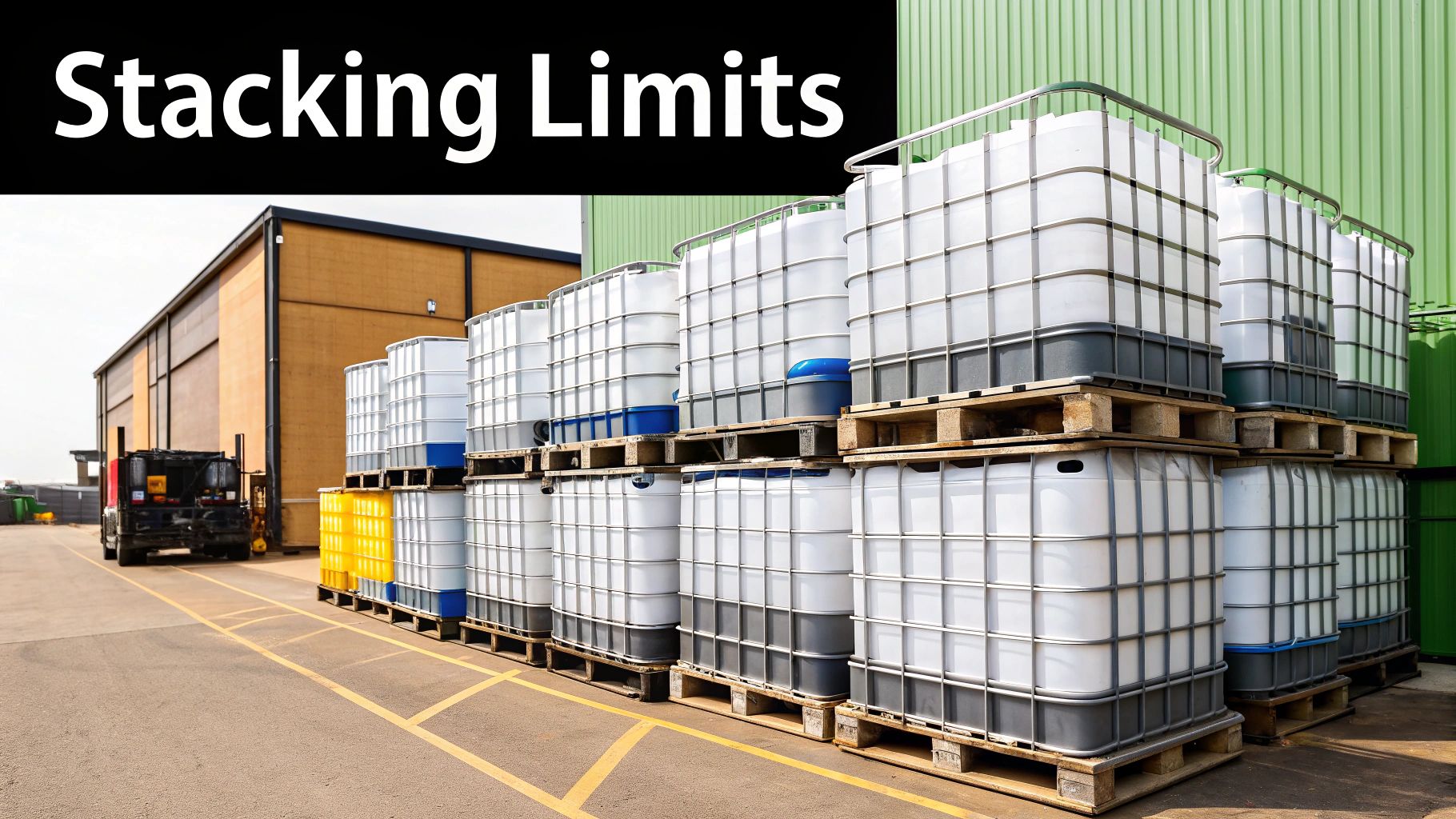
Reading the Stacking Load Rating
On the UN marking, you’ll see a small diagram of two stacked boxes. The number inside the top box is the golden ticket—it represents the maximum load in kilograms that can be safely placed on top of that specific tote when it’s stationary.
Let’s say the marking shows 1650 kg. This means the tote is built to support up to 1650 kg of weight on top of it. If you have a filled 275-gallon tote that weighs around 1100 kg, you could safely stack it on top, since 1100 kg is well under the 1650 kg limit. We offer a range of stackable IBC options built to meet these rigorous standards.
Static vs. Dynamic Stacking: A Crucial Distinction
It’s vital to know the difference between static and dynamic loads, because the UN rating only applies to one of them.
- Static Stacking: This refers to totes stored in a fixed position, like on a level warehouse floor. They aren’t moving. The UN stacking rating is designed specifically for this scenario.
- Dynamic Stacking: This involves stacking totes while they’re being transported on a truck, train, or ship. This is a whole different ball game. The forces from bumps, turns, and acceleration can multiply the stress on the bottom tote, easily exceeding its static load rating. As a rule, dynamic stacking is not recommended unless both the totes and the vehicle are properly secured and rated for it.
Safety First: Never stack IBCs with hazardous materials without first confirming that your totes, your storage setup, and your procedures all meet regulatory requirements. Your safety data sheets (SDS) and local regulations should always be your first point of reference.
As a general guideline, many caged poly IBCs are designed to be stacked two-high, provided the total weight doesn’t exceed the tote’s maximum gross mass rating. A standard 275-gallon caged tote usually has a stacking test load of around 1,605 kg (3,210 pounds), while its larger 330-gallon counterpart can often handle up to 1,933 kg (3,866 pounds).
Navigating Transportation and Compliance Specs
Knowing your IBC tote’s measurements is about more than just making sure it fits in your warehouse. It’s absolutely critical for meeting the strict rules of the road and ensuring safety. Regulatory bodies like the Department of Transportation (DOT) have specific guidelines that tie directly into a tote’s dimensions, capacity, and total weight. Getting this right isn’t optional—it’s a must for shipping anything legally, especially if you’re working with hazardous materials.
The key to it all is the UN/DOT marking on the tote’s data plate. Think of this series of codes less like a simple label and more like a detailed report card. It tells you everything from the tote’s design type (like 31HA1, which means a composite IBC with a plastic inner bottle) to the packing group it’s certified for (I, II, or III) and its maximum gross mass in kilograms.
Deciphering UN Markings and Mandates
This UN marking is where the physical IBC tote measurements connect directly to what you’re allowed to put inside and how you must handle it. For instance, a tote rated for Packing Group II substances can carry materials with a medium level of danger, but only up to its specified maximum weight. If you go over that limit—even if you still have room in the tank—you’ve just made that tote non-compliant and created a serious safety hazard.
On top of that, regulations require regular testing and recertification to prove the tote is still structurally sound throughout its service life.
For IBCs carrying hazardous materials, a visual inspection is mandatory every year. A more rigorous leakproofness test must be performed every 2.5 years (30 months). This recertification has to be documented right on the tote, acting as visible proof that it’s still fit for service.
Falling behind on these inspection schedules can lead to hefty fines and having your shipments turned away. Here in Canada, these requirements are enforced strictly to uphold safety standards, whether the totes are moving by truck, rail, or sea.
When we look at regional rules, California’s standards often set the pace for the industry. The state aligns with federal guidelines, such as those in CFR Title 49, which demand consistent inspections and recertification for any container transporting hazardous goods. You can find more details on California’s packaging regulations at C.L. Smith. This system ensures every single measurement, from the thickness of the bottle wall to the integrity of the valve, is checked and verified, confirming the tote is safe for public highways and commercial transport.
Common Questions About IBC Tote Measurements
Even with precise specs, real-world situations can throw a curveball. Whether you’re squeezing a tote through a tight workshop doorway or staging dozens in a warehouse, these answers will save you time—and headaches.
Clear measurements prevent logistic hiccups. Just a few centimetres can mean the difference between a smooth install and a last-minute workaround.
Will a Standard 275-Gallon Tote Fit Through a Regular Doorway?
In most cases, no. A 275-gallon IBC tote usually measures 48″ × 40″ at its base, while standard commercial doors top out at 36″ and residential at 32″–36″.
Key Dimensions Comparison:
| Item | Width | Height |
|---|---|---|
| IBC Tote Footprint | 48″ | — |
| Commercial Doorway | 36″ | — |
| Residential Doorway | 32″–36″ | — |
If you’re confined to 36-inch openings, plan for alternatives like roll-up doors or a loading bay.
How to Measure Valve Threads for the Right Adapter
Accurate caliper readings will keep leaks at bay. Two measurements are critical:
- Outer Diameter (OD): Measure straight across from one thread’s outer edge to the opposite edge.
- Pitch: Record the distance (in millimetres) between the crest of one thread and the next.
For example, S60x6 thread means a 60 mm OD with a 6 mm pitch. Match your numbers against a standard thread chart to pick the right adapter first time.
Are Food-Grade and Standard Tote Dimensions Different?
Surprisingly, they’re the same. A 275-gallon food-grade tote shares the 48″×40″×46″ footprint of its industrial sibling. The real distinction lies in materials: food-grade versions use virgin, FDA-approved HDPE and traceable valve components. Always confirm certification before handling consumables.
Required Clearance Above an IBC for Pump Access
Give yourself space to work. Plan for 12″–24″ of vertical clearance over the tote’s top surface. This allows safe installation and operation of top-mount pumps, hose connections, and access to the 6-inch fill cap. If you’re using bulkier equipment, consider boosting that to 36″.
For a complete range of IBC totes and accessories with reliable specs, visit IBC Tanks Canada. Our detailed data sheets and practical guides will help you streamline planning and avoid common pitfalls.
Article created using Outrank



